How to Elevate Boxed Cake Mix
A list of tested additions to make your next box of cake mix taste a little less out-of-the-box.
Here’s the thing about boxed cake mixes: there’s absolutely nothing wrong with them, and they exist for a reason. While we’ve got plenty of homemade cake recipes to choose from when you’re in the mood for a baking project, sometimes you need to whip up something sweet and satisfying, stat—whether for an impromptu get-together or because you forgot a loved one’s birthday (oops!).
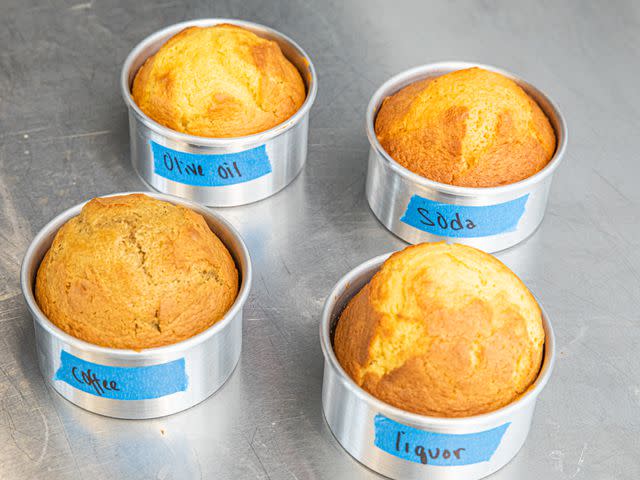
Serious Eats / Amanda Suarez
That doesn't mean cake mix can't be improved, though. There are plenty of add-ins you can use to deepen the flavor and/or texture of the cake, like nuts, spices, freeze-dried fruit, and flavorful fats like brown butter. While there are many options for customizing cake batter, you can’t just fold in whatever you want. Cake mixes are carefully designed food products that are engineered to work just right if you follow the package directions. They make the process incredibly easy, often not even requiring essential cake-batter steps like creaming butter and sugar. But that also means that alterations to the basic formula can sometimes have unintended and undesirable effects.
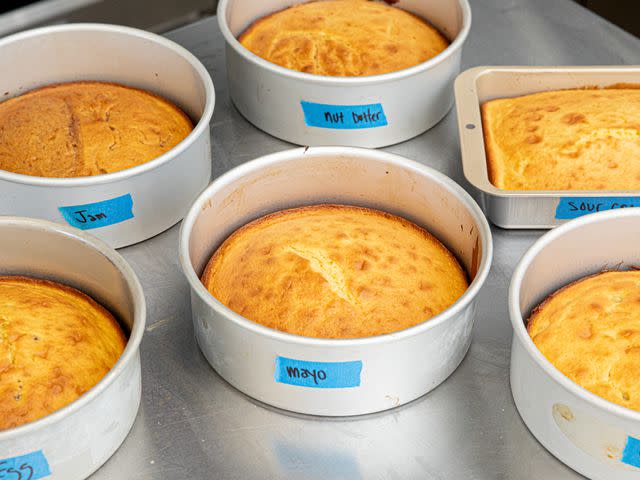
Serious Eats / Amanda Suarez
In doing research for this piece, we came across dozens of articles on this same topic that offered a variety of suggestions we were more than a little skeptical of. There's a good chance many of those articles never tested the tips they were sharing (because, LOL, that's the internet these days, don't you love it?). But we're a different kind of food brand, one that stands by its recommendations and roots them in real testing, so that's what we did here, cooking up round after round of boxed cake mix with different ingredients added, all so we could tell you which ideas are good and which…aren't.
While all of these ideas are for modifying the mix itself, one of the better roads to making a boxed cake mix taste more homemade and special is to make a frosting from scratch. Whether you prefer American or German buttercream, whipped cream, or ganache, whipping up a homemade frosting usually takes no more than 10 minutes, making it an easy option for a more personal touch. Once you frost your cake, you can decorate it with sprinkles, cookie crumbs, broken pretzels or potato chips, fresh or candied fruit, or anything else that’s calling to you.
What follows is a list of additions—some recommended, some acceptable, and some we most definitely advise against using—all scaled for a 15.25 ounce package (which is fairly standard) to make your next box of cake mix taste a little less out-of-the-box.
How We Tested
In order to get started, we identified the boxed-mix “upgrades” we were most doubtful of or just curious about. We wanted to see in what ways each add-in altered the flavor and the texture of the cake, whether negatively or positively. Did the additions affect how the cake rose, how it browned, or how it domed? Was there a change in the crumb? Did the ingredients add to the experience of eating the cake or take away from it? We then bought multiple boxes of the same cake mix, followed the package directions exactly as written, and mixed each sample for the same amount of time with whatever modification we were making.
The results are as follows: "recommended" modifications are ones we're confident will not harm most boxed cake batters, and in many cases stand to improve them, or, at the very least, alter them in pleasing ways; "acceptable" modifications are ones we didn't think were particularly good, but also didn't do anything outright objectionable to the cake—we probably wouldn't do any of them, but one could; "not recommended" additions are ones we found to be unappealing or downright disgusting, and don't think they should be on any list of cake-batter mods.
Recommended
Spices
Perhaps the simplest way to add a subtle boost of flavor is incorporating spices into your cake mix. Cinnamon and nutmeg are obvious choices, but other good options include cardamom, allspice, and star anise. You’ll want to be mindful of pairings: Try saffron (which is best bloomed in fat or liquid before adding to the mix), cardamom, or lavender with white chocolate frosting, or a variety of peppercorns with berries and stone fruit for topping your cake. It’s best to start off with small amounts, like 1/2 a teaspoon. Use your sense of smell to gauge whether or not you should add more, and take notes so you can refine your spice levels on future batches.
Malted Milk Powder
Former Serious Eats editor and baker extraordinaire Stella Parks has called malted milk powder the "umami bomb" of baking. The ingredient adds a depth of toasty, savory flavor similar to butterscotch or toffee, as well as a bit of creamy richness. You can add anywhere from a teaspoon to a tablespoon to enhance your cake.
Nut and Seed Butters
Adding nut and seed butters—whether you opt for almond butter, peanut butter, tahini, or pistachio paste—can significantly change the flavor of your cake for the better, giving it a nutty richness. We tested these additions both as swirls, in which we only slightly thinned the nut butter with some batter, then swooshed it into the mix without fully incorporating it, and also as a fully-incorporated flavoring. Swirling was not great—it created a gummy texture in the pasty swirled portions—but whisking half a cup of cake batter with half a cup of nut butter before fully mixing it with the rest of the batter resulted in a cake with a more even distribution of flavor and enjoyable texture.
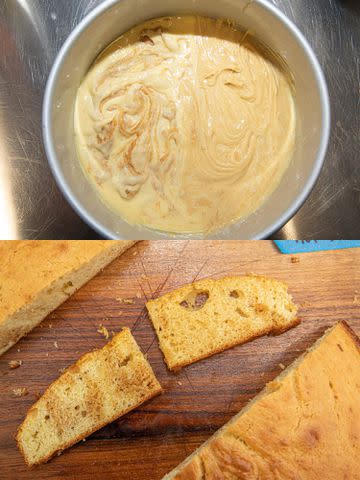
Serious Eats / Amanda Suarez
Browned Butter
Replacing the butter or oil called for on the box with browned butter is a great way to add nutty, toasted notes to your cake. Just be careful not to burn it, and make sure it cools to room temperature before you incorporate it into your batter.
Freeze-Dried Fruit
Stella has raved about the power of freeze-dried fruit in desserts before. When ground into a powder, the fruit can easily be incorporated into cake batter or frosting for an intense fruitiness and vivid color. Though some recipes (including Stella’s double-strawberry cake) call for up to 3 cups of freeze-dried fruit, we recommend starting with half a cup. Just be wary of adding too much, as it can throw off the flavor and texture of your cake.
Sprinkles and Chocolate Chips
Forgot to pick up the funfetti cake mix? Just add sprinkles to your batter (and your frosting) instead. If you opt for chocolate chips, you may want to dust them in a bit of flour to ensure they’re evenly distributed and don’t sink to the bottom of the cake when baking.
High-Quality Extracts
Even if you’re making cake from the box, it never hurts to spike it with a quality extract. With extracts—anything from lemon and almond extract to rose or orange flower water, not to mention high-quality vanilla—a little bit goes a long way. Just about 1/2 of a teaspoon should do the trick, though it will depend on the extract. Some are potent enough to pack plenty of flavor with just a few drops, while others can be measured in as described. When in doubt, it's best to start with less and use your sense of smell to gauge whether or not you want to add more.
Orange or Lemon Zests
Freshly grated lemon or orange zest will add freshness and give the cake a bit of zing. The zest of one lemon or orange should be enough for a box of batter.
Food Coloring
Food coloring is a fun way and easy way to (literally) brighten up your cake, especially if you’re making it for a kid’s birthday party. If you’re making a layer cake, you can divide the batter and add a few drops to each cake layer to create different colors before baking and stacking. This is an addition that works best on a white or yellow cake, since colors won't show up as well on darker mixes like chocolate.
Instant Espresso Powder
Instant espresso powder pairs especially well with chocolate and enhances its cocoa flavor, but you can also use it in a yellow or white cake batter. Adding about one teaspoon should be enough.
Sour Cream
For a cake with some extra tang that fluffs up nicely, adding sour cream is the way to go. You’ll want to add about 1/4 cup per box of cake mix. The only thing to note about this technique is that in our testing, it created some tunnels and tubes throughout the cake that may affect how the inside crumb looks to those with a more detailed eye. We think the flaw is a small price to pay for a decent boost of flavor, but consider yourself warned!
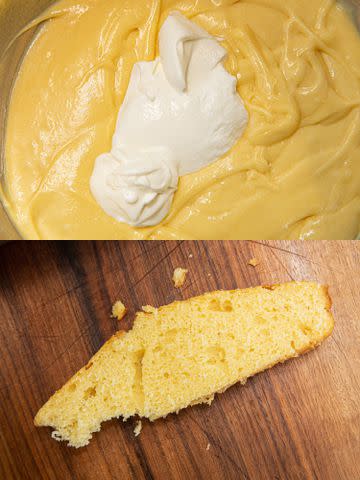
Serious Eats / Amanda Suarez
Acceptable
Replacing Butter With Olive Oil
Many websites recommend swapping out the recommended amount of butter or oil on the box with olive oil, presumably in an effort to recreate the flavor of an olive oil cake. We found that, while the olive oil flavor came through in the final cake, it doesn't match quite well enough with the flavor of the boxed mix to really taste like a proper olive oil cake. The effect is more like a kiddie birthday party cake that just happens to taste faintly of olive oil. It's not a total fail, but it's not the best either.
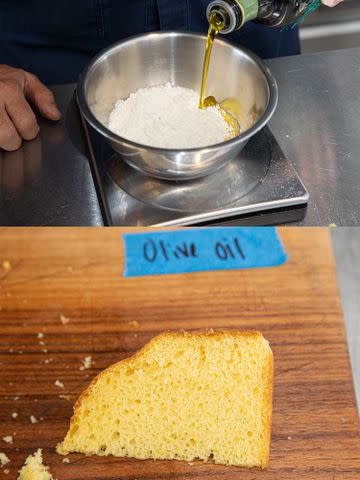
Serious Eats / Amanda Suarez
Nuts and Candied/Dried Fruit
The addition of nuts and dried or candied fruit (such as citron, citrus peel, or even ginger) can add both flavor and texture to a boxed mix, but they did seem a little odd and out of place in a light and fluffy cake—this trick tends to work better in a denser, more rustic dessert like banana bread or carrot cake. If you decide to go this route (which is a bit unexpected and not quite a natural fit), you’ll want to cut the nuts or fruit into small pieces, then dust them in a bit of flour before adding them to the batter; this will prevent them from sinking to the bottom and instead will allow the ingredient to be evenly distributed.
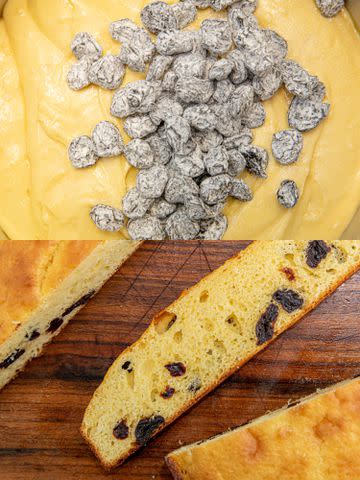
Serious Eats / Amanda Suarez
Liquor
When we thought about adding liquor to the cake batter mix, we wanted to be intentional about the flavor of the liquor we were adding—not all of them would work. We went with a Frangelico, which has a hazelnut flavor we thought would play well in the context of a cake, but it ended up yielding too boozy of a cake. Other liquors like Grand Marnier or allspice dram might work better here, but make sure to use a small amount when adding it to your batter—substituting no more than a quarter of the water or milk called for on the box with the liquor—so as to not create an overpowering flavor.
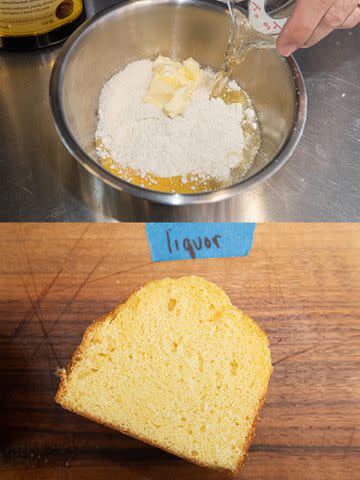
Serious Eats / Amanda Suarez
Replacing Water With Buttermilk
When we tried replacing the water in the cake batter with the same amount of buttermilk, we were expecting it to have a similar effect as sour cream. Instead, buttermilk created a denser cake, and it barely altered its flavor, with less browning than that of the baseline cake. If you prefer a denser cake—which we think isn’t a common texture for this type of cake—this is the way to go, but other than that, buttermilk didn’t add anything of note to the cake.
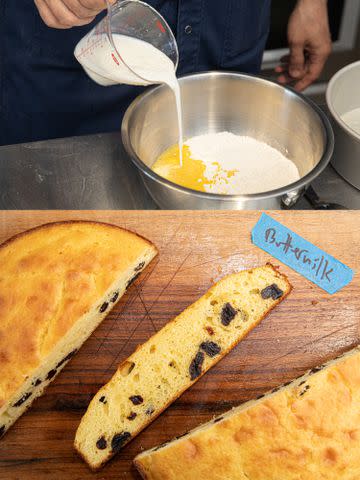
Serious Eats / Amanda Suarez
Replacing Water With Soda
While replacing the water called for on the box with the same amount of soda didn't harm the cake, it also didn't help. We used Fanta Orange Soda with the hope its citrus flavor might be a pleasant addition to a yellow cake mix, but the resulting cake tasted like we'd merely infused one processed food product with the artificial flavor of another—which is to say it wasn't very good. We didn't try other soda flavors, though, so while we're skeptical that any soda will do much to improve a boxed cake mix, it's certainly possible some will work better than others.
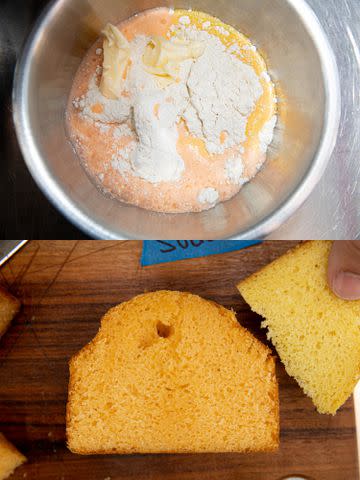
Serious Eats / Amanda Suarez
Adding an Extra Egg
When we used one more egg than the box called for in our tests, the resulting cake was particularly light and fluffy, though it did create more doming on top. The addition of an extra egg was good as far as texture was concerned, but it also added a discernibly eggy flavor, which we would rather do without.
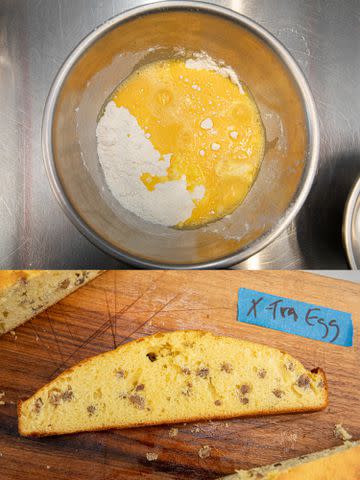
Serious Eats / Amanda Suarez
Not Recommended
Replacing Water With Coffee
This was one of the tests we thought might yield great results, but the cake tasted like two-day old drip coffee had been infused into it. If you want to add a coffee flavor to your cake, you’re better off sticking with espresso powder.
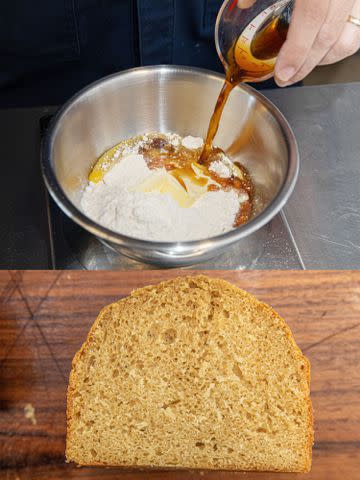
Serious Eats / Amanda Suarez
Mayonnaise
Almost every article we saw online on this topic mentioned adding a few tablespoons of mayonnaise to boxed cake batter for a moister cake. We can only conclude most of those writers never tried it, because we found the vinegary flavor it added completely repulsive. It's really not a shocker, folks—the savory, vinegary flavor profile of mayo doesn't belong anywhere near a cake.
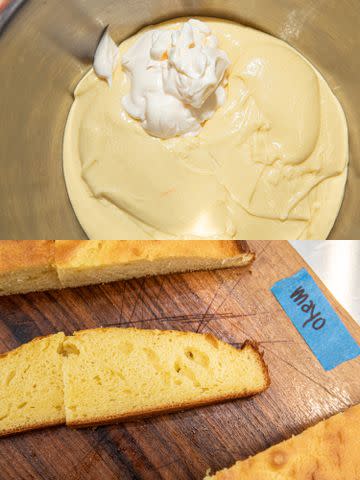
Serious Eats / Amanda Suarez
Jam
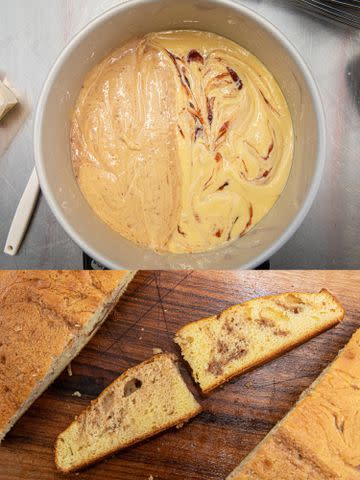
Serious Eats / Amanda Suarez
We tested the addition of jam in boxed cake batter in two ways: as a swirl in the pan right before baking, as well as fully incorporating it into the batter. The former created a greasy, oily cake that felt under-baked due to the jam's extra moisture, while the latter route wasn't flavorful enough. It would be better to add freeze-dried fruit powder to the cake mix itself for a fruity effect, or spread the jam between the layers of cake and leave it out of the cake itself.
Read the original article on Serious Eats.

